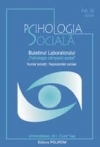Relaţiile dintre acţiunile de asistenţã şi reprezentãrile sociale: o contribuţie empiricã
Relations between actions of assistance and social representation: an empirical contribution
Author(s): Ida Galli, Roberto FasanelliSubject(s): Psychology
Published by: EDITURA POLIROM S.A.
Summary/Abstract: The study of the relationship between social practice and social representation emerges as one of the key issues within the history of social representation theory. Nevertheless, these relationships are still today misunderstood and, paradoxically, rarely investigated. The following study is aimed at identifying the mechanisms through which social representations are used within a given context, specifically in the context of „taking responsibility for” and „taking care of” the patient. The sample used for the study is made up of subjects for whom Alzheimer’s disease is the object of symbolic daily interactions made through language, in accordance with the epistemological premises of the Theory of reference. From the internal structure point of view, the same sample was divided into the following subsamples: (1) formal caregivers (medical and paramedical personnel in health centers); (2) informal caregivers (relatives of the patient). In order to study the social representations of Alzheimer’s disease as shown in the various subsamples involved in the research, we start from the semantic-lexical field. The first component studied, „Information”, was constructed through a lexical frequency statistical analysis using material collected through free-association test. The data collected was later used as a means of accessing the second component of the research, the „Field of representation”, identified through a descriptive statistical analysis. To identify the central nucleus and the peripheral elements of this type of social representation, the free-associated terms used by the subjects interviewed were analyzed by using the Vergès’ „Evocation hiérarchisée” technique. Finally, the same subjects that had participated in the free-association test were given a „semidirective” interview, through which it was possible to have access to the content of the social representation studied. The data from this phase of the research was analyzed for its categorical-frequential content. The results obtained provide interesting observations on the social representations of health and illness as shown by the people involved, directly or indirectly, with the altered or pathological states of the organism.
Journal: Psihologia socială
- Issue Year: 2004
- Issue No: 14
- Page Range: 24-48
- Page Count: 25
- Language: Romanian

